Additional author: Justin Burt, postdoctoral research associate, Department of Crop and Soil Sciences, University of Georgia Tifton Campus.
Grazing management requires accurate estimates of forage availability to adjust forage supply to meet animal needs. However, incorrect forage availability estimates can negatively impact important grazing-management decisions such as stocking rate and grazing time. Visually estimating pasture yield is inexpensive and fast, but untrained persons can give biased and unreliable estimates.
One of the easiest, most affordable, and most reliable estimation options is using a grazing stick or pasture ruler. If you do not have a grazing stick or pasture ruler, you can use any ruler or yard stick for measurement. This publication provides step-by-step instructions on how to use a grazing stick to make important forage-management decisions.
How to Use a Grazing Stick
- Walk across the pasture in a diagonal or zigzag (Z-shaped) pattern, taking a height measurement every 10–20 steps.
- Place the grazing stick upright at the bottom of the plant canopy (Figures 1A and 1B), but do not press down on the forage.
- Place your hand against the stick where the average height of the plant canopy and markings on the stick meet (Figure 1C).
- Write down the number and repeat these steps across multiple locations in the field (Figure 1D). You should expect to collect a minimum of 15–20 data points per field.
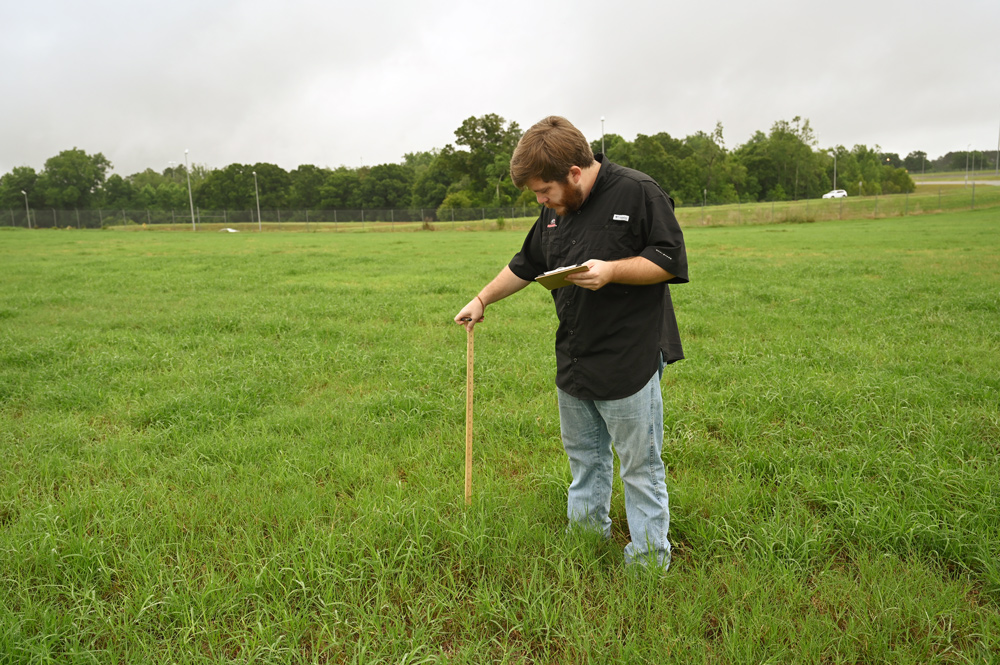
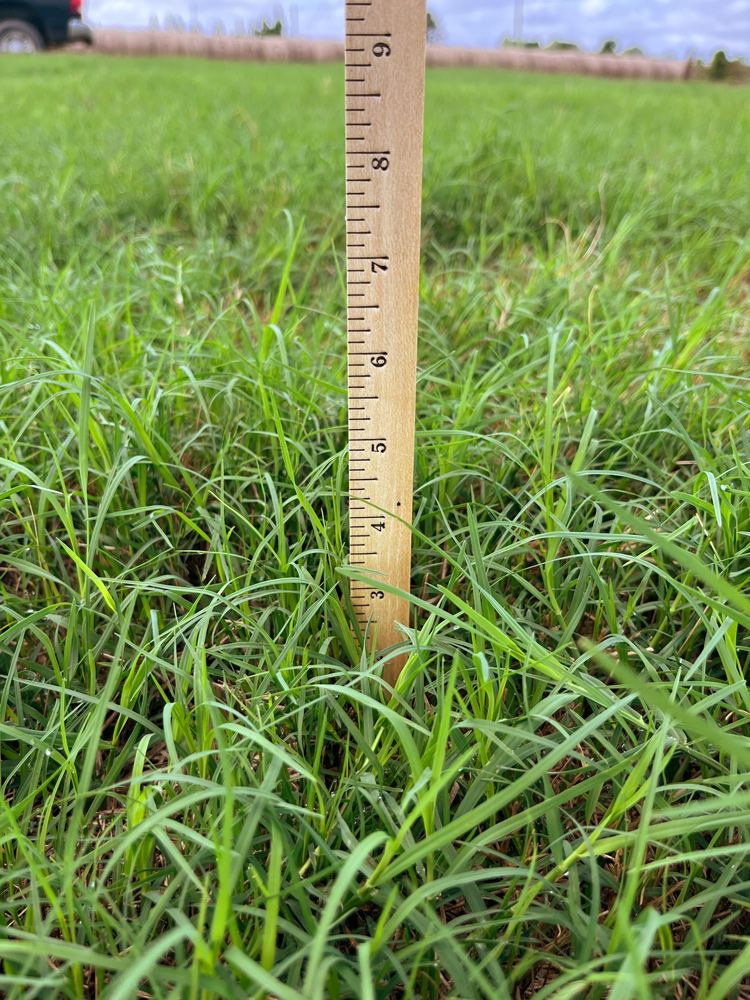
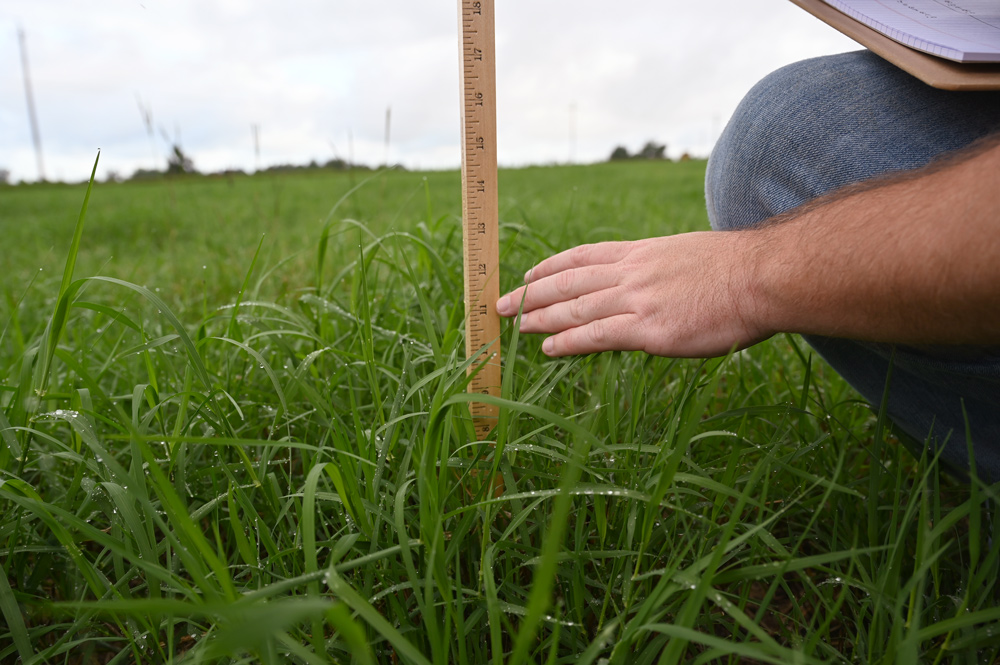
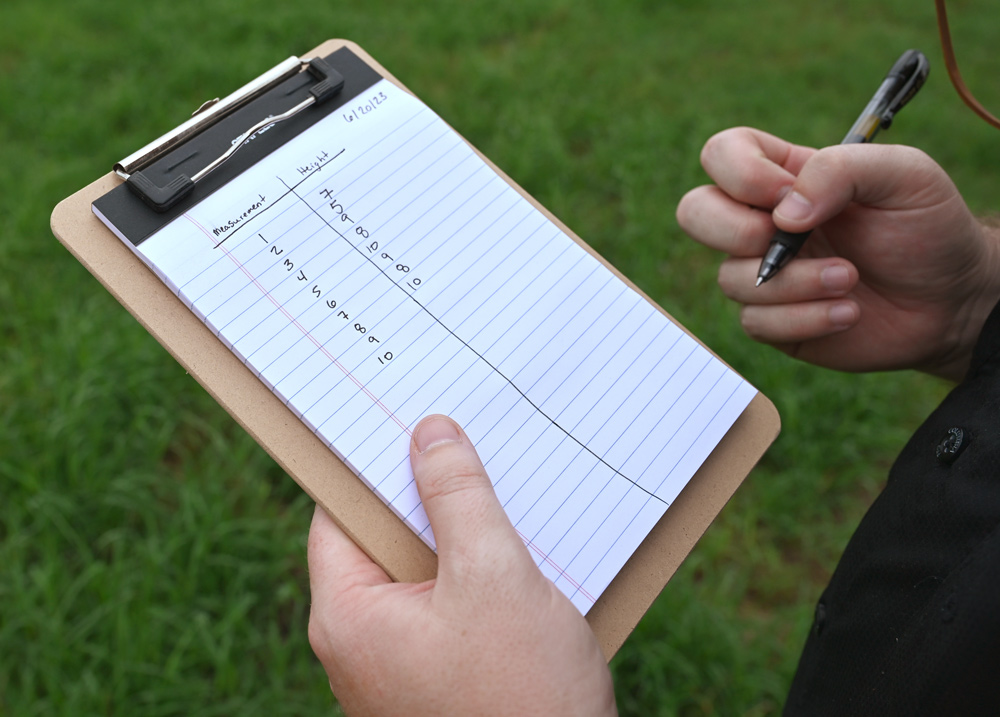
Mistakes to Avoid When Measuring Forage with the Grazing Stick
To minimize measurement errors or bias, be sure to take forage height measurements at consistent spacing throughout the pasture (such as every 20 steps) to avoid selecting only the tall spots (especially near excreta), areas just inside a gateway, or near fence lines. Ensure that the grazing stick is perpendicular to the soil surface.
To ensure an accurate forage measurement, do not take measurements as shown in Figures 2A and 2B: Avoid pulling back on the grazing stick (Figure 2A), and do not compress the taller portions of the forage canopy down to the shorter portions (Figure 2B).
If there is variability in the canopy height, be sure to take measurements from both the taller and shorter areas, and then adjust for the percent coverage of each component. In mature forage stands, in which lodging may occur, straighten the plants up to get an accurate reading, but do not pull and stretch the plants to their full height as this will cause errors.
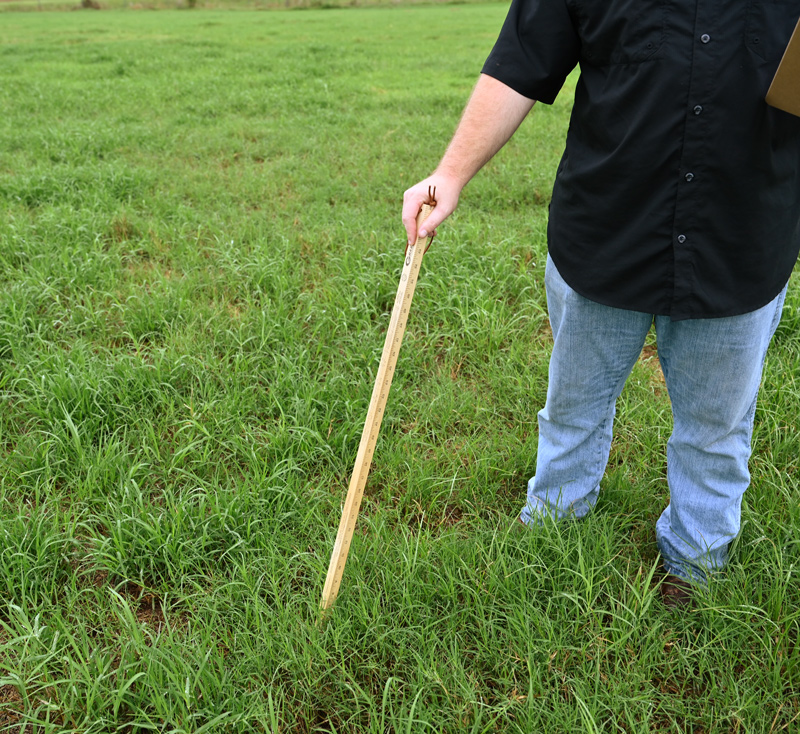

How to Predict Available Forage Mass
Available forage mass is calculated using Equation 1. First, determine the average beginning harvest height by adding all the forage height measurements together and dividing that by the number of measurements collected.
Next, determine the optimum final grazing height. Table 1 lists the optimum final grazing height for different forage species. Subtract the final height from the beginning height to determine the inches of available forage. The final step is to determine the pounds of available forage per acre; use Table 2 to find the available forage per inch per acre based on the forage species.
| Forage species | Begin grazing minimum height (in.) |
End grazing minimum height (in.) |
|---|---|---|
| Alfalfa | 10 | 4 |
| Annual clovers | 8 | 3 |
| Annual ryegrass | 8 | 3 |
| Bahiagrass | 8 | 3 |
| Bermudagrass | 8 | 3 |
| Pearl millet | 20 | 8 |
| Small grains | 8 | 4 |
| Sorghums/Sudans | 20 | 8 |
| Tall fescue | 8 | 4 |
| White clover | 6 | 3 |
The ranges in available forage in Table 2 account for the density of the stand. If the stand is fairly open, meaning you can see the soil through the grass (50% to 70% ground coverage), then use the lower end of the range; if the ground coverage is dense (exceeding 90%), then use the higher end of the range. Once the pounds of available forage per inch per acre has been determined, multiply this number by the number of inches to get the pounds of available forage per acre.
| Forage Species | Average lb of forage/inch/acre | Range of lb of forage/inch/acre |
|---|---|---|
| Alfalfa | 225 | 75–400 |
| Alfalfa–grass mixture | 225 | 75–400 |
| Annual clovers | 200 | 100–300 |
| Annual ryegrass | 250 | 75–400 |
| Bahiagrass | 200 | 100–350 |
| Bermudagrass | 260 | 150–500 |
| Small grains | 150 | 75–250 |
| Tall fescue | 210 | 100–350 |
| Tall fescue + white clover | 190 | 80–325 |
Equation 1
Available forage per acre = (beginning height–final height) x (lb of grazeable forage per inch per acre)
Example 1
Let’s say we have a bermudagrass stand with an average beginning grazing height of approximately 8 in. and a final grazing height of 3 in. Bermudagrass has an average of 260 lb of forage per inch per acre, but it can range from 150 to 500 lb. Using Equation 1, we get:
available forage/acre = (8 in–3 in) * (260 lb of forage/inch/acre)
available forage/acre = 1300 lb of available forage per acre
How Many Days Will it Take to Graze This Pasture
To determine the number of days of grazing, use Equation 2. First, define the forage utilization, which is the percent of available forage that the animals are expected to consume. As intensity of the grazing rotation increases, so will grazing utilization (see Table 3).
| Grazing management system | Forage utilization (% of stand) |
|---|---|
| Continuous | 30–40 |
| Rotational | 50–70 |
| Intensive rotational (i.e., strip grazing) | 75–80 |
Next, define dry-matter intake, which is determined by many factors including the class of livestock and their body weights. In general, we expect animals to consume 2% to 4% of their body weight daily. Table 4 lists livestock classifications and their estimated dry-matter intakes. Multiply the available forage per acre by the number of acres and the percent utilization to determine the numerator in Equation 2. The denominator of Equation 2 is determined by multiplying the animals’ weights by their percent intake and the number of animals. Finally, divide the numerator by the denominator in Equation 2 to get the days of grazing per paddock.
| Class of animal | Forage consumption (% of body weight) |
|---|---|
| Dry beef cow | 1.80–2.00 |
| Lactating beef cow | 2.00–2.50 |
| Stocker cattle | 2.50–2.75 |
| Sheep and goats | 3.50–4.00 |
| Horses | 2.50–3.00 |
Equation 2
Example 2
Let’s assume we have 35 dry beef cows that weigh 1,100 lb on average. Each day, these cows consume 2% of their body weight, and they are rotationally grazing a 20-acre bermudagrass pasture with 1300 lb of available forage/acre. The estimated percent utilization in the rotational system is 60%.
days of grazing = 20 days
How Much Area Do I Need to Feed My Cows for a Set Number of Days
Calculate your forage-area needs using Equation 3. First determine the number of acres required by multiplying the average animal weight by the percent intake, number of animals, and days of grazing. Then divide this number by the product of available forage and percent utilization.
Equation 3
Example 3
Let’s assume we have 35 dry beef cows that weigh 1,100 lb on average, these cows consume 2% of their body weight, have a 60% utilization, and are grazing for 7 days. There is also 4000 lb of available forage. How many acres are required to maintain these cows for 7 days?
number of acres required = 6.9 acres
Summary
A grazing stick provides producers with a cost-effective and relatively accurate option to make critical grazing-management decisions for their operations. It is important for producers to know what their production goals are by taking into consideration the forage type being utilized, the class of animal, and which grazing management strategy they are implementing. Using this key information and a few simple forage height measurements, these calculations can provide producers with an effective grazing plan.
The calculations in this publication are an important aspect of building a grazing plan. This video from the Georgia Forages YouTube channel further demonstrates how to properly use a grazing stick and how to perform these calculations.
For more information or assistance in using a grazing stick in your production system, contact your local Extension office (or call 1-800-ASK-UGA-1).
Status and Revision History
In Review on Aug 09, 2024
Published on Aug 20, 2024


























































